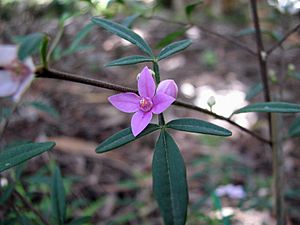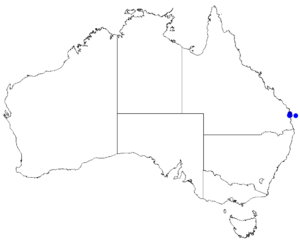Keys boronia facts for kids
Quick facts for kids Key's boronia |
|
|---|---|
 |
|
| Boronia keysii in Maranoa Gardens | |
| Conservation status | |
| Scientific classification | |
 |
|
| Occurrence data from Australasian Virtual Herbarium |
Key's boronia (scientific name: Boronia keysii) is a beautiful flowering plant found only in Queensland, Australia. It's a bushy shrub with thin stems and pretty pink flowers that have four petals. You can see it flowering for much of the year.
Contents
What Key's Boronia Looks Like
Key's boronia is an open, bushy shrub that spreads out. It usually grows to about 2 meters (6.5 feet) tall and wide. Its young stems are covered in tiny, brownish, star-shaped hairs.
The leaves grow in pairs opposite each other on the stem. They are made up of smaller parts called leaflets. Each leaf can have one, three, five, or seven leaflets. These leaflets are about 8 to 75 millimeters (0.3 to 3 inches) long. They are oval or spear-shaped. The leaflet at the end is usually longer than the side ones, measuring about 15 to 51 millimeters (0.6 to 2 inches) long.
Flowers and Fruit
The flowers grow in groups of three to six. Each group sits on a small stalk about 3 to 5 millimeters (0.1 to 0.2 inches) long. The individual flowers have their own smaller stalks, about 5 to 15 millimeters (0.2 to 0.6 inches) long.
Key's boronia has four sepals, which are like small leaves that protect the flower bud. They are egg-shaped or triangular and have a hairy back. The four petals are a deep rose pink, but can sometimes be white. They are about 5.5 to 8 millimeters (0.2 to 0.3 inches) long and also hairy on the back.
Inside the flower, there are eight stamens, which produce pollen. Four of these stamens are slightly longer than the other four. Key's boronia flowers throughout the year, but mostly from May to November. After flowering, it produces a small fruit called a capsule. This capsule is about 4.5 to 5 millimeters (0.18 to 0.20 inches) long and contains four black seeds.
How It Got Its Name
The plant Boronia keysii was first officially described in 1926 by a scientist named Karel Domin. He studied plant samples that James Keys had collected in 1909 near Lake Cootharaba.
The description was published in a journal called Bibliotheca Botanica. The second part of the plant's scientific name, keysii, was chosen to honor James Keys, who collected the first samples of this plant.
Where Key's Boronia Lives
Key's boronia is only found in the Cooloola region of Queensland, Australia, especially near Lake Cootharaba. It usually grows in the areas where forests meet heathlands. You can often find it growing under other trees in open forests.
Protecting Key's Boronia
Key's boronia is considered a "vulnerable" species. This means it is at risk of becoming endangered if we don't protect it. Both the Australian Government and the Queensland Government have laws to protect this plant.
The main things that threaten Key's boronia include:
- Changes to the water level in the ground.
- Fires that happen too often or at the wrong times.
- Invasive pine trees from nearby plantations that spread into its habitat.


